At first glance, the Sarca Excel is a Delta clone with a few added creases in the sheet metal, explaining the public perception that they are the same. However, our Technical Editor Drew Frye has owned and used both, and our testing reveals how this conclusion ignores some very important differences that impact performance. The Excel is a new generation anchor, with the same holding and rapid setting characteristics we have come to expect from modern anchors by Rocna, Manson, and Spade. What makes it so different?
Non-clogging. With no scoop to collect mud or roll bar to catch trash, and a V-top, it never holds enough mud to hinder re-setting. A little rinse may be required to get it clean, but never the blasting and digging we resort to when cleaning scoop and rollbar anchors.
Setting. The nose is sharp and noticeably turned downward. A ballast chamber and a narrow flange along the sides, help produce an initial bite that is instantaneous. In fact, the first thing the bottoms sees is a concave edge, the same as other new generation anchors. Like any good anchor, it immediately rolls upright and begins to dig, setting within a shank-length in good sand and a little greater distance in softer bottoms. Of course, ballast can only be added by sacrificing weight somewhere else, but much of the savings comes from dispensing with the roll bar, so the loss in fluke area compared to other modern anchors is minimal.
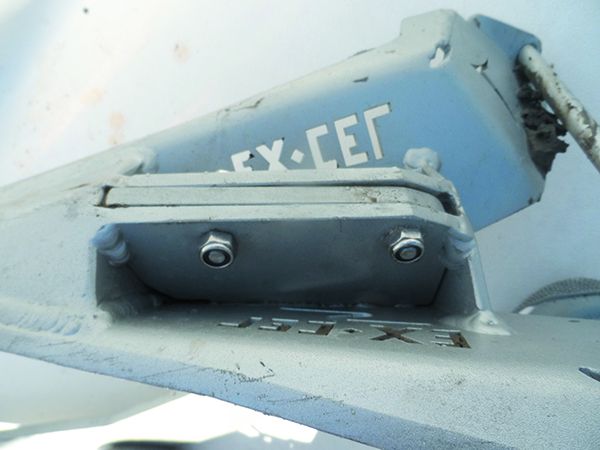
Convex vs. Concave.
As we discussed in our recent report, the public perception is that you need a concave scoop for good holding (see “A Second Look at Anchor Fluke Shape,” January 2021). Surely a V-top, like that of the Delta or CQR, will work as a plow, setting perhaps, but then plowing through the bottom at relatively low load. This is where subtle differences in the Excel change everything.
Unlike a Delta or CQR, the Excel has a flange around the perimeter, which prevents the soil from easily sliding off the fluke. As a result, the anchor behaves more like two concave anchors placed side-by-side at an angle.
Instead of the soil being sheared and allowed to slide out of the way, it is pressed outwards into the existing soil, creating an area of compressed soil around the anchor larger than the projected area of the fluke.
The Lewmar plow has an upward tail-kick that does little to drive the anchor deeper or increase hold; by the time the dirt reaches the back of the fluke it is loose and all the kick-up does is build a mound of loose soil. The Excel tail kick, on the other hand, is outwards, directing the soil against undisturbed bottom. This outward angulation also helps with the initial roll onto the toe (see PS January 2021, “A Second Look at Anchor Fluke Shape”).
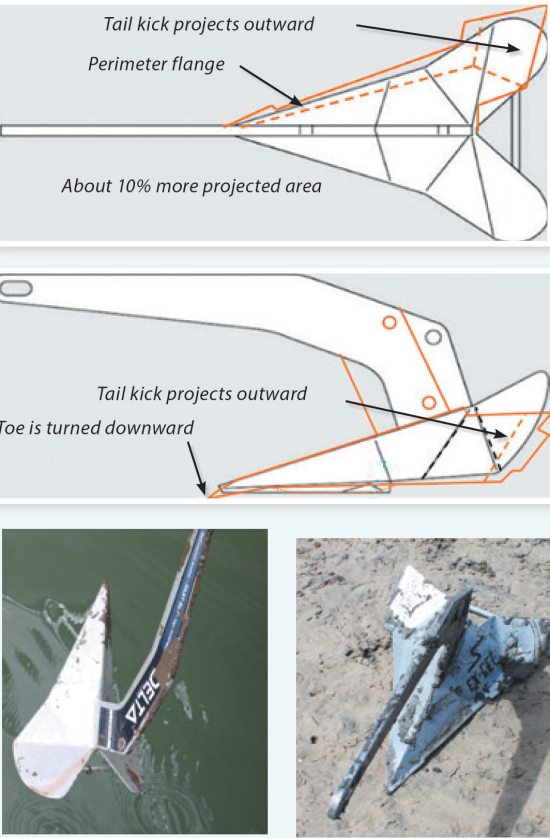
The differences between the Lewmar Delta anchor and the Australian-made Excel seem relatively small. However, based on our testing, the subtle changes appear to improve setting in mud and sand bottoms, and perhaps more importantly, resist clogging when the anchor is forced to reset by a change in wind direction.
- Top view of Excel (in red) superimposed over the Delta outline. The solid lines are the anchor outlines and the dotted lines are the creases.
- The Excel profile view (in red) shows close similarities in the shank angle and positioning. Not the toe is angled slightly downward to encourage soil penetration.
- The crease in the flukes of the Delta anchor is clearly visible in these photos from our anchor reset test. The broadest part of the flukes angle upward in a ‘tail-kick.’
- The Excel’s ‘tail-kick’ directed outward, helping to compress the soil around it. With no scoop to collect mud, or rollbar to catch trash, it never held enough mud during our tests to hinder re-setting. The V-shaped top of the flukes also helps shed mud.
What do the numbers say? Evaluating anchor holding data is always like herding cats, with 15-30 percent variation within a single location and up to eight times variation between fine sand and soupy mud. We went to three of the same consistent sand, mud, and soupy mud locations we have been using for anchor testing for the past 10 years, anchored the boat with a big Fortress anchor, and used sheet winches to apply load to the test anchors, which were set off the stern. The anchors were fitted with 6 feet of chain, polyester rode, and placed at 12:1 scope. To make certain the anchor was not still creeping forward, the reported holding capacity is the minimum tension maintained during a 30-second pause in the winching. We averaged of three repetitions, moving laterally four feet between trials. Pulls often varied as much as 20-35 percent, so consider only the trends, not close rankings in the tables provided (see page 10).
Manufacturer ratings are very subjective (what bottom, how much safety factor). Also, holding capacity/pound is not the be-all and end-all; you can always skimp on a few feet of chain and go up a size. Consistent setting and resetting are more important. Steel is better for weeds and hard bottoms, but alloy sure is nice for kedging and handling without a windlass.
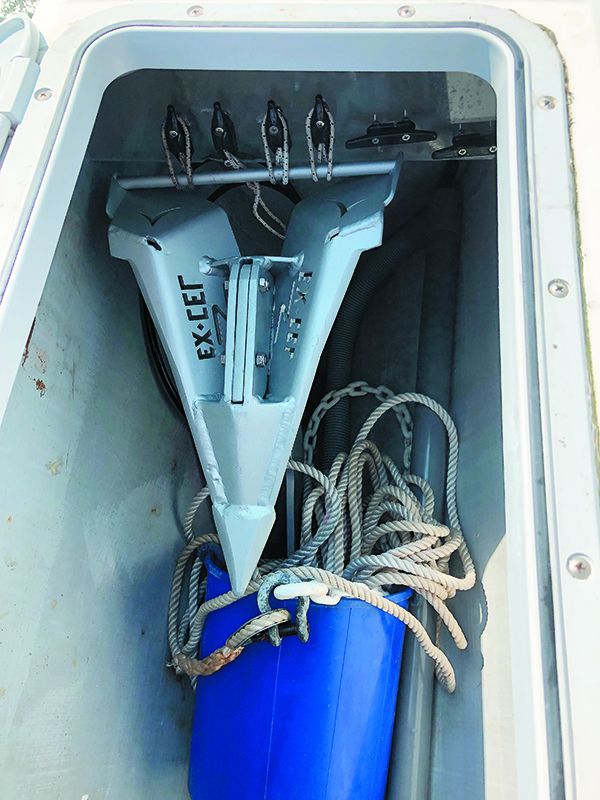
Stable Dragging. Most anchors fail completely when overloaded. They pop out of the bottom and bound or maybe, drag but with three to five times less resistance. Then the roll bar fills up with sticks and the anchor might as well be a rock on the end of a rope. The Excel inherited one excellent trait from the Delta; it tends to be stable when it drags, moving through the mud with high resistance, without fouling or tripping. Hopefully, if the gusts are short lived, it will stay in. But this is not a huge victory; any anchor that drags is very likely to foul on something or hit a soft spot and fail. Primarily this is helpful when the anchor must reset multiple times.
Short Scope. Although we did not did not focus on this, the relative difficulty in removing the anchor after deep setting suggested it would rank in the middle of our test group.
Rapid Setting. The Delta required a gentle hand on firm sand and often did not set deeply. In mud, waiting 10 minutes really helps. All of the other anchors set immediately.
Reset Testing. The Excel never failed to reset. Scoop anchors are generally very reliably, but can fail if loaded with mud. Pivoting fluke anchors frequently fail to reset. Delta and CQR anchors frequently fail to engage firm bottoms.
Self Launching. Like the Delta, a roller–friendly shank and ballast compartment hidden in the toe allow it to slide off the roller without assistance. Small wonder everyone copies the Delta shank.
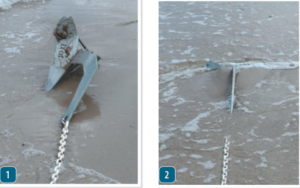
sand. The anchor set before it had travelled the length of its shank..
Other Observations
Our test boat has only an anemic outboard for power setting. After setting the anchor in very firm, hard sand, we noticed that the anchor was not fully buried and could be wobbled by hand, but it never came loose due to wind and wave action.
Bump setting is a good option for hard bottoms and light winds (see “Setting an Anchor in a Small Boat,” Practical Sailor, November 2017). The Manson Supreme, Mantus M1, and Northill set deeper with light force in the same area. In windy conditions, the Excel set well in the hardest bottoms, and holding capacity was very high.
Stowability. The fluke is detachable, with the shank coming up from below through a very robust socket. It locks into position under tension and is retained by a pair of non-load bearing stainless bolts. There are two holes in the shank near the fluke. The upper hole is for lashing to the roller and the lower holes is for a tripping line.
Material. Though not anodized like Fortress anchors, they are made from 5053 aluminum, which is very corrosion resistant in a marine environment. Size 4 and greater use 7075 for the shanks for additional strength. No corrosion has been noted by PS testers and cruisers.
Aluminum vs. Steel. We compared the Excel #1 to steel anchors of the same size. Common sense tells us that steel should penetrate better, but experience tells us that the aluminum Fortress bites more quickly and holds better than the steel Danforth.
At the hard sand location the Excel never failed to catch within a foot, even on resets. At a notoriously stick- and shell-laden soft mud site, it cut through the trash more easily than any anchor we have tested at that location. Sailors that own both aluminum and steel Spade anchors have commented on slight differences, but they still love them both.
One PS tester has used an aluminum Excel as his bower for years. Our feeling is that if weight really matters, and particularly if you have soft bottoms, aluminum can make a lot of sense even for the bower. However, if, like most sailors, you don’t mind a few more pounds, you’ll probably be happier with galvanized steel. We’re not fans of stainless for anchors or chain.
Strength and Weight. The shank is about 1/3 thicker to compensate for the reduced strength of aluminum. Although the alloys used are slightly weaker than those in the steel version, aluminum is nearly three times lighter (2.7 g/cm3 for aluminum vs. 7.8 g/cm3 for steel). Aluminum thickness is increased to compensate, resulting in an anchor that is just as strong with only 55 percent of the weight. Of course, the anchor is only part of the total ground tackle mass. If chain is used; 200 feet of chain will weigh six times as much as the steel anchor attached to it. On the other hand, 200 feet of nylon rope and minimal chain can weigh less than a matching steel anchor.
Effect of Weight on Setting. The steel anchor and chain will retain 87 percent of their mass under water. An aluminum anchor will weigh 40 percent less, but the tip weight is comparable to steel, since Excel uses lead for ballast. In very soft mud, the aluminum anchor sets upright more quickly than steel.
Weed. Several areas feature weeds and lots of trash in the form of sticks and dead vegetation. The Excel penetrated as well as any anchor in this weight class we tested and was immune to the fouling that plagues roll bar designs, resulting in more consistent and stronger setting.
Rock. The worst areas in our test program were cobbles, and jointed shale slabs with the occasional shallow pocket. The cobbles have defeated every anchor under 25 pounds I’ve tested, so a weak performance was no surprise.
Diving revealed that unless the fluke is physically big enough to reach through the softballs-sized rocks and into the underlying sand and gravel before the shank grounds out, it has no chance of setting. It just pushes rocks around.
On the jointed shale, the only anchor that catches reliably is our 1940s Northill; the fisherman anchor-like point is perfect for dropping into holes and cracks.
New generation anchors perform rather poorly. Steel, pivoting fluke, Danforth-style anchors sometimes do better. Our 25-pound Delta mostly just slides on its side, right over the cracks. The CQR is useless. The alloy Excel was unimpressive, releasing without notice when the wind shifted just a bit, but only a little worse than other new generation anchor in the same weight class. The steel version, we suspect, would perform identically. In truth, you need to anchor somewhere else. We tested at these locations primarily because they are favorite fishing spots!
Anchor Holding in Mud and Sand
| MEASURED/ESTIMATED TENSION | WEIGHT | SPECIFIED BOAT SIZE | SOUPY MUD | MUD | SAND |
|---|---|---|---|---|---|
| DELTA* | 14 pounds | 20-27 feet | 80 lbs. | 300 lbs. | 450 pounds |
| MANTUS M1, 6KG | 13.1 pounds | 16-20 feet | 150 lbs. | 520 lbs. | 740 pounds |
| MANSON SUPREME | 15 pounds | 18-30 feet | 160 lbs. | Not tested > | 1200 pounds |
| NORTHILL UTILITY, 6R | 12 pounds | 15 feet | 130 lbs. | 460 lbs. | 800 pounds |
| EXCEL #1, 3.5 KG** | 7.1 pounds | 160 lbs. | 160 lbs. | 1200 pounds | |
| GUARDIAN G11** | 4 pounds | 15-21 feet | 240 lbs. | 240 lbs. | >1200 pounds |
Kedge. A second anchor is occasionally indispensable. You might run aground and need a pull. Narrow canals can require fore-aft anchoring, and storms or tides can suggest one of several V-anchor configurations. All of this is easier if the second anchor bites well.
Our favorite has long been the Fortress, but the Excel is also light, is much easier to break out (a Fortress can be a real bear when deeply set) after hard pulling, plus it makes a good bower for when you lose your primary because it is suitable for more bottoms. This versatility makes the alloy Excel a strong candidate for best secondary anchor.
Stowable Storm Anchor. The aluminum means a really large anchor will be easy to handle, and with only two bolts, it can be assembled in minutes. Unlike a Fortress, it can handle changes in wind direction. (For more on super-size anchors, see PS November 2008, “Product test: Heavyweight Anchors for Challenging Conditions.”)
Test Boat Rode Tension
| MEASURED/ESTIMATED TENSION | WIND | TENSION |
|---|---|---|
| RODE TENSION | 10 knots | 20 pounds |
| RODE TENSION | 20 knots | 70 pounds |
| RODE TENSION (ESTIMATED) | 30 knots | 160 pounds |
| ESTIMATED RODE (ESTIMATED) | 50 knots | 440 pounds |
Durability. Given the beefy construction and tester experience with larger sizes, we expect the Excel to hold up well. Aluminum is generally regarded as less durable, but we’ve had both galvanized and aluminum anchors in wet anchor wells for decades. Although aluminum can corrode, the damage is usually cosmetic.
Conclusions
Anchor performance is the result of complex interactions between balance and angles that are best evaluated through rigorous testing. No single feature—roll bar or not, convex or concave—can be considered in isolation. Only performance counts, across a range of seabeds and through multiple resets, and the Excel delivers high holding capacity, and fast setting and resetting without clogging.
PS tester Rick Neeves has been using an Alloy #4 Excel on his Light Wave catamaran as his primary anchor for many years, and he’s tested enough anchors to know what he likes. Our experience with the much smaller Excel #1 has been just as positive, outperforming much heavier anchors. We would go with a steel Excel as a primary for better performance in difficult bottoms, but the alloy version is our favorite for a second anchor or ultra light primary.
DELTA,
www.lewmar.com
MANTUS ANCHORS,
www.mantusanchors.com
MANSON ANCHORS,
www.mansonanchors.com
EXCEL ANCHORS,
www.groundtackle.com
GUARDIAN ANCHORS,
www.fortressanchors.com
































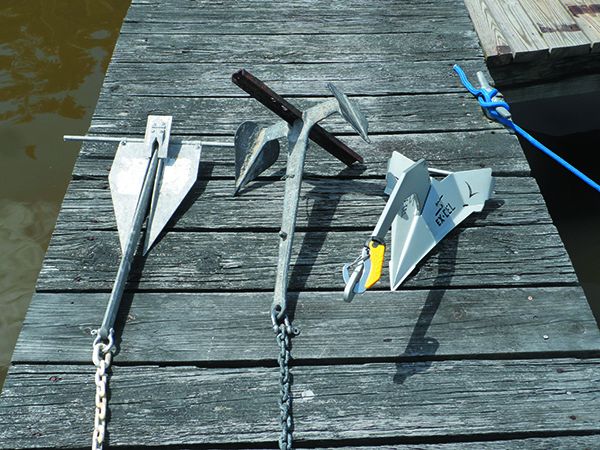




I feel that anyone enjoying this article may wish to know about the anchor test videos coming from Steve of SV Panope. Just a few examples of things he’s observed: in some bottoms some scoop designs are very reliable whereas others that look similar reliably fail to reset; a couple of anchors do pretty well in (his) cobblestone; sometimes a larger size of a given anchor performs nonlinearly better than a smaller size… Where there’s overlap I’m curious to hear more about where Drew’s conclusions converge/diverge with Steve’s.
Practically: I grew up with a fear of cruising that turned out to be entirely due to not knowing how far I could trust my anchor, and you rigorous and transparent testers have cured me! Thank you!